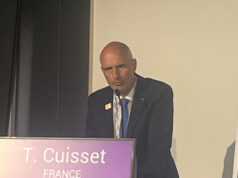
Data from a pilot imaging study of commissural alignment in trancatheter aortic valve implantation (TAVI) has found that more than 30–50% of cases had overlap with one or both coronary arteries. Gilbert HL Tang (Mount Sinai Medical Center, New York, USA) and colleagues also noted that initial Sapien 3 (Edwards) orientation had no impact on alignment, but that specific initial orientations of Evolut (Medtronic) and Acurate (Boston Scientific) improved alignment. They say that optimising valve alignment to avoid coronary overlap will be important in coronary access and redo TAVI.
The findings from ALIGN TAVR (Alignment of transcatheter aortic-valve neo-commissures: Impact on final valve orientation and coronary overlap) were reported in JACC: Cardiovascular Interventions, and were also due to be presented at the American Society of Cardiology’s Scientific Sessions Together with the World Congress of Cardiology (ACC.20/WCC; Chicago, USA), scheduled for 28–30 March, which has been cancelled.
Tang and colleagues write: “As TAVI expands to patients with longer life-expectancy, the issues of access to the coronary arteries for diagnostic and therapeutic management, valve durability, and repeat valve intervention with TAVI in failing transcatheter heart valves (THV) (that is, redo TAVI) become important. In addition, computational modelling has suggested that commissural alignment may reduce THV leaflet stress, particularly in the setting of elliptical annuli.”
The study team evaluated the impact of THV deployment orientation on commissural alignment. Pre-TAVI computed tomography (CT) and procedural fluoroscopy were analysed in 828 patients who underwent TAVI (483 Sapien 3, 245 Evolut, 100 Acurate-neo) between March 2016 and September 2019 at five centres. Coplanar fluoroscopic views were coregistered to pre-TAVI CT to determine commissural alignment. Severe overlap between neo-commissural posts and coronaries was defined as 0–20º apart. Sapien 3 had one commissural post crimped at 3, 6 ,9, 12 o’clock. Evolut “Hat” marker and Acurate neo commissural post at deployment were classified as centre back (CB), inner curve (IC), outer curve (OC), centre front (CF), and matched with final orientation.
Initial Sapien 3 crimped orientation had no impact on commissural alignment. Evolut “Hat” at OC/CB at initial deployment had less severe overlap than IC/CB (p<0.001) against left main (15.7% vs. 66%) and right coronary artery (7.1% vs. 51.1%). Tracking Evolut “Hat” at OC of descending aorta (n=107) improved OC at deployment from 70.2% to 91.6% (p=0.002) and reduced coronary overlap by 36–60% (p<0.05). Acurate neo commissural post at CB/IC during deployment had less coronary overlap versus CF/OC (p<0.001), with intentional alignment successful in five out of seven cases.
Discussing the findings, Tang et al say: “Although the incidence of coronary access after TAVI remains low and mostly successful, interventional cardiologists who are not familiar with TAVI may have difficulty in coronary access, due to the random location of the commissural posts relative to the coronary orifices. While this issue may be less important in THV with short stent frames, it may be more problematic with supra-annular THV with tall stent frames, due to the need for a coronary catheter to traverse around the commissural post and across the stent frame to engage the coronary. Commissural alignment in TAVI may therefore allow the THV neocommissures be placed away from the coronaries, to facilitate coronary access more directly across the stent frame.”
They acknowledge the study’s limitations, which include that the CT-fluoro coregistration technique needs a larger scale validation with post-TAVI follow-up imaging to confirm the actual THV orientation, and that the association between commissural alignment and the ability to perform coronary access and redo TAVI remains hypothetical, given that only a handful of cases were done in this large series. They add: “Multiple anatomic and procedural factors may be important when evaluating feasibility of both procedures.”
And they suggest: “Transcatheter valves and delivery system designs could ensure optimal THV alignment with native commissures to facilitate coronary access and redo TAVR.”
Hasan Jilaihawi (NYU Langone Health, New York, USA) agrees in an accompanying comment, also published in JACC: Cardiovascular Interventions. He calls upon device manufacturers to address the issue: “To keep our TAVI future bright, there is a clear need for mainstream device manufacturers to align the stars (and help align their devices to our patients’ commissures), by creating dedicated solutions to this problem.” Jilaihawi says the authors should be commended for their efforts in highlighting “this thus far unaddressed problem for TAVI, and for their noble attempts to ameliorate it”.













